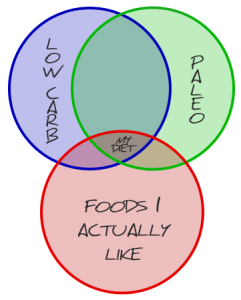When you make and eat the vast majority of your meals at home, it’s easy to not think about just how out of step from the rest of the world your diet has gotten. Substitutions are automatic—for example, whenever a recipe calls for “cream” I just read “coconut milk”—and a lot of foods just simply aren’t on my awareness anymore.
Then come the holidays and large family meals.
I would be perfectly happy to indulge in some carbs once or twice a year except for the fact that eating too many carbs tends to give me a headache, among other things. (That sort of thing is not uncommon for people who go low-carb, and is often called a carb hangover or carb flu.) But even so, I could still indulge as long as I kept my portions small and ate plenty of meat, and have in the past.
The problem now is the milk. The problem is, milk can be in just about everything. Especially if you’re pressed for time and stressed and opt for one of those prepared meal packages from the grocery store. Gravy: often has cream. Mashed potatoes: usually have milk. Green bean casserole: just forget it. Stuffing/dressing: can apparently have milk, too. Pumpkin pie: it’s a custard. It has milk.
My extended family is pretty understanding, but I wouldn’t ask them to go without their usual comfort foods, either. We’ll often bring our own low-carb, or dairy-free versions of things like cranberry sauce, pumpkin pie, ice cream, etc. and everyone is pretty good about ingredient disclosure. If we end up with some dishes I can’t eat and two versions of other dishes it’s no big deal.
But this year no one was up for a big celebration or a lot of cooking, so we went with one of those prepackaged meals. That’s how I found out dressing can have milk in it (not by eating it—I’m a compulsive label reader). I was left with the meat, the green beans (which were, uh. Not that great.), a cauliflower and pumpkin mash we had made (which did turn out great), and our version of creamy cranberry sauce (more on that later). And our own pumpkin pie. With coconut milk ice cream.
You don’t realize how common an ingredient milk is until you have to avoid it. You think of cheese and cream and of course, actual milk, but that’s barely the start of it. Even Cool-Whip, the supposedly non-dairy alternative to whipped cream, has sodium caseinate in it (that’s a milk protein). Many flavorings you wouldn’t think of, such as salt-and-vinegar potato chips, have milk powder or whey powder. It’s in some dark chocolates, too, so you have to check the label even if it doesn’t say “milk chocolate.” It will turn you into a compulsive label reader.
Getting back to Thanksgiving. We’ve been making a pumpkin pie using Dana Carpender’s simple almond crust and a straightforward filling with stevia and coconut milk instead of sugar and cream for several years now with great success. But this was the first time we’d tried the cauliflower mash, so none of us knew what to expect.
We’d gotten a pumpkin in our veggie box, so I’d done a search on Pinterest for “pumpkin” and “keto.” This is one of the recipes that popped up. I don’t think it’s exactly keto, but it is low-carb, so we decided to try it.
It turned out great! This is coming from someone who isn’t a big fan of cauliflower and has a hot-and-cold relationship with pumpkin (I love sweet pumpkin things; not so much of a fan of the savory squash taste). Everyone agreed that this recipe was a winner, and I’m definitely keeping it in my arsenal to try again.
For the cranberry sauce, we have a low-carb version we’ve been making for years (again from Dana Carpender), but after we started eating more ketogenic I went looking for ways to up the fat content. The creamy cranberry recipe on Food.com was one of the first I found. Substituting stevia for the sugar, of course.
This recipe makes a pretty thin sauce, though, so we went back to Dana Carpender’s for the base. For the sour cream we used homemade soured coconut cream. (This is fun to make and has the added benefit of being probiotic! I usually use a ginger bug as my starter culture.)
This is now my favorite way to make cranberry sauce. It’s rich and complex and wonderfully sweet tangy. For this batch I let the whole thing sit and ferment for a few hours so it had some extra bite to it. I eat it with turkey and chicken, of course, but also with pork and beef, and it’s great with broccoli or green beans.
Dietary restrictions may mean you can’t go the traditional route, but it doesn’t have to mean giving up your holiday meals. As annoying as dietary restrictions are, it can lead to some really great recipes.







Recent Comments